Eleven Most Endangered Places, 2007
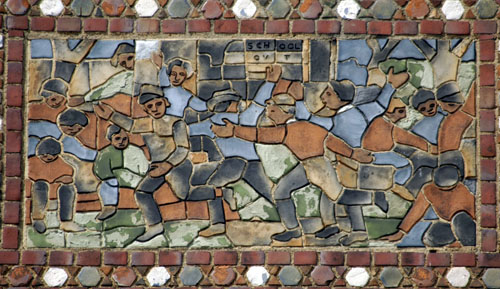 |
| "School's Out." One of a pair of tile panels at Carr School. Photo by Gary Tetley |
LANDMARKS' 2007 ELEVEN MOST ENDANGERED PLACES LIST IS ALREADY OBSOLETE. Since the list's release last May, two of the then-threatened buildings have been lost. (Reports of those losses follow.) Sadly, the Brecht Butcher Supply Company Buildings at 1209 Cass Avenue from our 2006 list were demolished earlier this year. But there is some good news. Better futures await three places from the 2006 list: the house at #4 Windermere Place, which seems to be safe from immediate threat; the Oakherst Park Concrete Block Historic District, which has stabilized; and the fire-ravaged Nord St. Louis Turnverein, which is slated to be rebuilt by Blue Shutters Development.
The National Trust for Historic Preservation compiled its first list of America's most endangered places in 1988. A call for action, the list was designed to demonstrate the diversity of the nation's imperiled historic resources and to identify the variety of threats that plague them. In 1992, LANDMARKS decided to follow the Trust's example, but limit our examples to properties located within the boundaries of St. Louis city. Finding new life for endangered buildings, however, can be a slow, tedious process. LANDMARKS, in contrast to the National Trust, elected to retain buildings from the previous year's list on each succeeding list until they are either too far gone to be saved or have been rescued. Carr School (pictured above) is the only site on our initial list from 1992 that still languishes on our 2007 roll call. Six others (also on the north side) are held over from subsequent years. Since we strive for geographic balance on both our Eleven Most Endangered and Eleven Most Enhanced lists, the four buildings new to this year's endangered tally (two in Midtown and two in south city) are identified by an * in the following text.
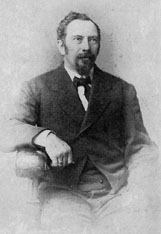 | 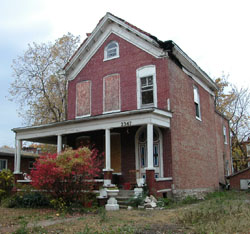 | 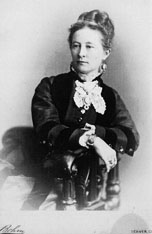 |
Photos of Andrew and Laura Einstmann courtesy Paul Philippi, Laura's great nephew. Landmarks photo |
The *Andrew and Laura Scott Einstmann House at 2347 Virginia is a fine and rare example of an Italianate country house now enveloped in a dense city neighborhood. Built circa 1870 (the porch is more recent) for a wealthy commission merchant and his young wife of Southern descent, the house was designed as a semi-rural summer retreat from the city's heat and congestion-a fairly common practice by the elite. (Historical footnote: This particular family chose to winter in the great Southern Hotel on Washington Avenue. Andrew perished in the conflagration of 1877; Laura survived to claim that she and her mother were the only guests to escape.)
The now-deteriorating Einstmann House is clearly eligible for single site listing in the National Register. But since it falls outside the boundaries of the Tower Grove Heights National Register District, there is currently no protection from demolition or alteration. Vacant since 2001 and considered a problem property for some time, the house remains in the hands of a limited liability corporation that has so far resisted neighborhood efforts to either maintain it or sell it. LANDMARKS Researcher Andrew Weil (who did the primary research for the building) is in touch with the Tower Grove East neighborhood association and potential developers.
Putting the *Sun Theater at 3627-31 Grandel Square on our endangered list is merely an early warning. The pedestrian-friendly Renaissance Revival theater, built by the German Theater Society in 1913 from plans by Widmann & Walsh, is graced by an elaborately decorated front elevation complete with grotesque theatrical masks and heavy garlands. Inside, the $120,000 playhouse originally featured an 1800-seat, first-floor theater for German-speaking stock companies; a lecture hall was located on the second floor. The 1915 City Directory documents the two original names in use at the same time: The Victoria Theatre and The German Theatre.
With World War I came a national backlash against Germans and the theatre closed. Reopened after the war under new management as The Liberty, the building (with seating reduced to 1000) has since housed movies, vaudeville, burlesque, a night club and an evangelical church. (Later name changes included the World, the Sun and the Lyn.) LANDMARKS' Midtown National Register nomination from 1978 described the remains of the interior as follows: "Bits of maroon, red and gold are faintly visible through the gloom of an interior picked by scavengers." Vacant since 1981 and now owned by the city's Land Reutilization Authority (LRA), the exterior (sporting volunteer trees and a cheerful "Sun" sign installed and maintained by Grand Center) is starting to show alarming signs of deferred maintenance. Recent hopeful rumors suggest that a media-related reuse is under consideration.
Carr Elementary School at 1421 Carr Street also continues to deteriorate.
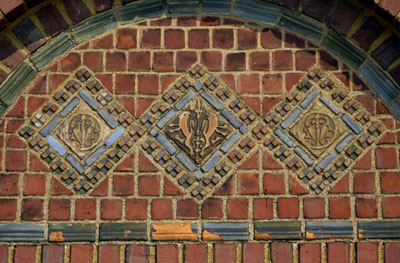 |
| Detail from Carr School. Photo by Gary R. Tetley from 2007 |
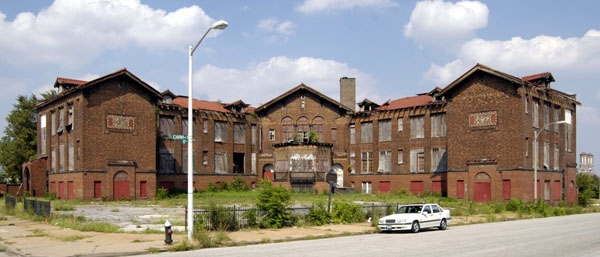 |
| Carr School. Photo by Gary R. Tetley from 2007 |
Designed by William B. Ittner, the school was completed in 1908 and closed in 1983. The L-shaped, tile-roofed grade school is remarkable for its unique tile murals (see above and lead photos by Gary Tetley) as well as its projecting kindergarten bay. After the school's closure, the Carr Square Tenants' Association acquired the building in the hope that it could be converted to a community center. Those plans stalled and no others have proved feasible. Nonetheless, we are encouraged by a just-in-time rescue of Neighborhood Gardens-a property which had remained on our endangered tally year after year. In 2007 it appeared on the Eleven Most Enhanced list!
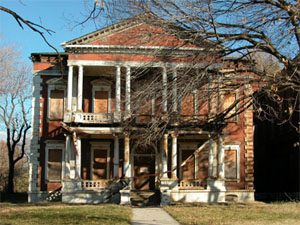 |
| Clemens House. Photo from 2006 by Michael Allen |
Months after a city judge ordered the sale of the antebellum James Clemens, Jr. House at 1849 Cass Avenue, a for-sale sign went up on the front wall. So far as we know there have few nibbles. No telling whether Blairmont Associates LC, the owner, is serious about selling the house, built in 1858 from plans by Patrick Walsh with its adjoining chapel from 1896 designed by Aloysius Gillick. What is certain is that roof failure is severe, especially at the chapel. The south wall of the house's dormitory addition has begun collapsing into the house. Both structures have also been subjected to repeated visits from scavengers. Immediate stabilization is necessary, a substantial expense unlikely to happen under current ownership.
In February 2007, Gilded Age Development announced plans for a large retail development on Lafayette Avenue across the street from the City Hospital-Gilded Age's multi-year rehabilitation project. A rendering published in the St. Louis Business-Journal showed a preliminary scheme for the area west of 13th street (cleared of buildings in 2006) and indicated a future two-block expansion to the east.
 |
| Royse/Noero model houses on Bohemian Hill |
These blocks include scattered 19th and early 20th century brick homes and tenements, some rehabbed and others in need of attention, along with three contemporary infill houses. Designed by Royse/Noero and built through a collaboration between Youth, Education and Health in Soulard, the Washington University School of Architecture and LANDMARKS, the much-publicized model houses were envisioned as the start of a larger infill project for *Bohemian Hill.
Public concern following the release of the site plan centered on the suburban nature of the retail development and the possible use of eminent domain to acquire Bohemian Hill houses. Although the city's Land Clearance for Redevelopment Authority has stopped purchasing buildings in those blocks, the future for the remaining fragment of Bohemian Hill is unclear. In November, Gilded Age broke ground on the retail center. More
This spring LANDMARKS learned of a threat to a vanishing building type: the livery stable. (In late 19th and early 20th century St. Louis, owners paid to board their horses away from genteel residential streets; another related and once-prevalent building type was the carriage repository.) R.W. Crittenden built the first section of the two-story brick Romanesque Revival *Livery Stable at 3401 Locust Street in 1885. Additions from 1888 and 1889 were followed by a major remodeling in 1902 by architect Otto Wilhelmi. Located on what became Automobile Row, the building's use by the 1920s as the salesroom of the Salisbury Motor Company was a predicable evolution.
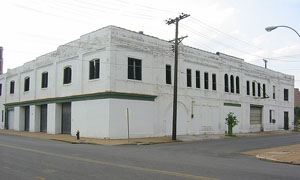 | 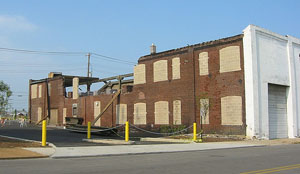 |
| Photos Courtesy Paul Hohman 2007, vanishingstl.blogspot.com |
During more recent years as a storage facility, the stable's windows were filled in and street elevations were treated to a coat of white paint. In 2004, St. Louis University outbid one of Locust Street's most prolific developers and acquired the building. After entertaining the idea of moving its theater department to the building, the university announced its intention to replace it with surface parking to serve the new Chaifetz Arena some four blocks to the south. Midtown lies within the 19th Ward, a ward not included in the city's voluntary preservation review program. Thus, the university was able to get a demolition permit without formal public review. The livery stable's plight was publicized by LANDMARKS, Channel KSDK and the Riverfront Times, but the National Register-eligible building is gone.
The Old North St. Louis Restoration Group has made amazing progress toward stabilizing the storm-damaged Mullanphy Emigrant Home at 1609 N. 14th Street, especially given the setback experienced earlier this year. After securing ownership and forming the Historic Mullanphy Alliance, the group's task grew when another storm on March 31 did even more damage. The group quickly called on the generosity of E.M. Harris Construction Company, which installed essential wooden shoring in advance of a down payment. Next the Alliance, facing a $350,000 stabilization estimate, jumped into fundraising. Stan Jones of the St. Louis Equity Fund organized a highly successful event at the Schlafly Bottleworks. LANDMARKS' staff also took action. Research Associate Michael Allen helped host a fundraiser at the Royale; Office Manager Susan Tschetter organized a benefit concert at Christ Church Cathedral. The flurry of fundraising events ended with a rousing show at the Tin Ceiling organized by Researcher Lindsey Derrington and Jeff and Randy Vines of STL--Style; bands included the Bearded Babies, featuring Researcher Andrew Weil. Meanwhile, Missouri Preservation held its Most Endangered Buildings List press conference at the Emigrant Home, garnering statewide media attention.
 | 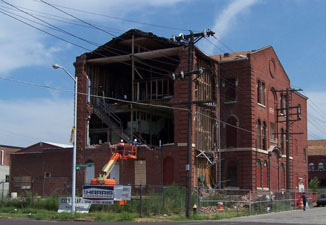 |
| Photos courtesy of the Old North St. Louis Restoration Group. |
Donations so far have come from scores of individuals plus many organizations including the Society of Architectural Historians-Missouri Valley Chapter, the St. Patrick's Day Committee and AIA St. Louis. LANDMARKS provided a $5,000 no-interest loan.
Perhaps the largest contribution was not money, but rather bricks (well, backing block) and mortar from the Masonry Contractors Association. By this October, the alliance had raised $63,000 and enough materials to start rebuilding. A new foundation for the south wall was completed by November; masonry work should begin soon. More information and images: www.savemullanphy.org
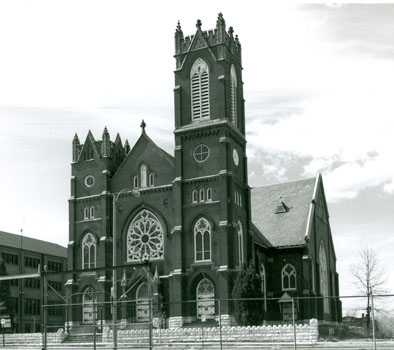 |
| Landmarks photo from our 1993 church survey |
Little has changed since last year at Bethlehem Lutheran Church, located at 2153 Salisbury in the Hyde Park historic district. While the church congregation is investing in the surrounding neighborhood with an ambitious plan of new construction and rehabilitation using state and federal historic rehab tax credit, it has not made any plan for the future of its Gothic Revival home. The City Landmark-designated church building actually is an 1895 reconstruction of a fire-damaged building that had just been completed in 1894. Undaunted, the German-speaking Missouri Synod Lutherans hired Hemminghouse & Vollmer to rebuild the church according to the original plans by architect Louis Wessbecher.
But demographic shifts and gradual population loss in Hyde Park eventually pared the congregation down to a group that meets next door in a 1930 school building. The historic resolve displayed by the congregation must be directed toward its 19th century home before the church loses more of its architectural features (many of the stained glass windows and all of the copper roof ornaments are long gone). It is ironic that St. Louis is home to the Missouri Synod, the eighth largest Protestant denomination in the country. Concordia Seminary appears to be thriving; Trinity in Soulard, considered the synod's mother church, received an Enhanced Award in 2001. The synod's landmark northside church needs help.
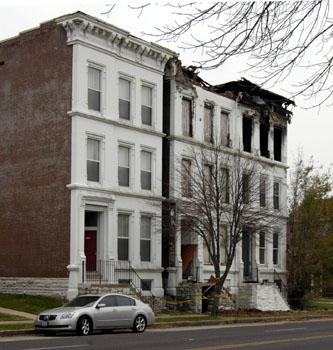 |
| Photo 2006 by Gary R. Tetley |
Two of the three Givens Row buildings (2903-07 Delmar Boulevard) are gone. Built in 1884 by contractor, later WU School of Architecture benefactor Joseph B. Givens, the Italianate-style row was an elegant example of the limestone-faced dwellings that once lined Piety Hill streets. In recent years two of the three buildings have been vacant-the center one city-owned, the easternmost one owned by a holding company. Although fire struck last year, the city took no action until the Building Division abruptly ordered emergency demolition in September 2007. The third building (occupied as rental housing) becomes the sole Givens Row remnant.
Designed in 1909 by prominent St. Louis architect George D. Barnett, the Mullanphy Tenement at 2118 Mullanphy Street was commissioned by the Mullanphy Emigrant Relief Fund to demonstrate that up-to-date apartments could be developed for working-class people in addition to the wealthy, who already enjoyed modern apartment living.
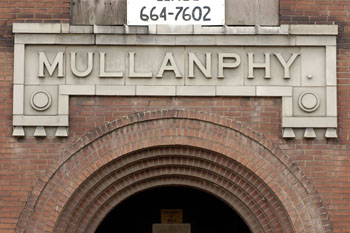 |
| Photo 2006 by Gary R. Tetley |
Funds ($63,000) from Bryan Mullanphy's estate provided for a handsome brick and terra cotta exterior plus amenities including maple floors, slate sinks, steam heat and communal clothes drying machines. Many apartments had balconies; all received ample daylight from large double-hung windows equipped with screens and Holland shades. The Mullanphy pedigree is stated in large block letters above the elaborate central entrance as the building sits vacant and deteriorating on a charming brick street that also bears the family name.
Wellston Station, better known as Loop Pavilion, at 6111 Dr. Martin Luther King Drive, is a picturesque Arts & Crafts landmark at western end of the Wellston Loop commercial district.
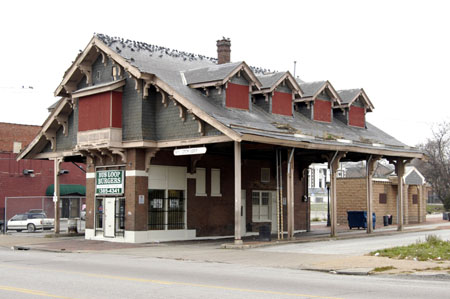 |
| Photo 2006 by Gary R. Tetley |
The building designed by Martin Arhelger was built in 1911 for the St. Louis Suburban Railway streetcar line, part of the United Railways monopoly. Bi-State Development Agency acquired United Railways in 1963 with plans to replace streetcars with bus lines. The last nostalgic streetcar ride terminated at the Wellston Station on May 21, 1966. Bi-State retained the pavilion for bus passengers, but gradually allowed decay to set in. In 2006, Bi-State (now Metro) abandoned plans for conversion of the building to a farmer's market and deeded it to the city's Land Reutilization Authority. Alderman Jeffrey Boyd responded by using Community Development Block Grant funds to hire LANDMARKS to prepare a National Register nomination. Listed in the National Register on May 2, 2007, Wellston Station awaits adaptive reuse.
